| Pages:
1
2 |
David K
Honored Nomad
        
Posts: 65072
Registered: 8-30-2002
Location: San Diego County
Member Is Offline
Mood: Have Baja Fever
|
|
A mission-era discovery? CHORAL PEPPER (new) BOOK CHAPTER + PHOTOS added.
Some of you know my search has been ongoing for the ruins discovered in 1966 south of L.A. Bay.
Photos taken in 1966 and links to my searches can be found in this web page: http://vivabaja.com/1757
Well, it was Choral Pepper who got me interested in finding the site as she nor any of the survivors of the 1966 expedition could recall the exact
location.
Besides Choral, I talked to Bruce Barron (who is the one standing by the ruins in the Desert Magazine photos), J.W. Black, and Ricardo Costillo of
Mulege... None could recall where the wall was other than south of L.A. Bay and after their visit to Bahia las Animas to gather clams (as noted in
Erle Stanley Gardner's 'Off the Beaten Track in Baja' c1967.
Here is the chapter from the unpublished final Baja book by Choral Pepper... revised from her famous 1973 Baja Missions book:
Santa Maria Magdalena-In Search of A Mission Legend:
Because this formerly lost site motivated so many requests for directions following its discovery recounted in my early Baja book, I will describe
details of the route as closely as I can recall. I tried to find it again in 1995, but we ran into a storm that partially washed out the bridge and
much of the road that now loosely follows the old Padres Gulfo Camino, thus making it impossible to establish a camp and re-explore the area.
During the 1966 expedition with Erle Stanley Gardner, one goal was to locate a lost mission trail known as the Padres Gulfo Camino, believed to follow
along the Gulf coast between Bahia de los Angeles and Punta San Francisquito. As Gardner’s caravan plunged along an abandoned road that once served
the ore mills at Las Flores we speculated, somewhat derisively, upon the ability of a team of drivers for the Automobile Club of Southern California
who reportedly had turned back after about twenty miles. Then we reached the end of that twenty miles! The scene changed.
No longer was there any trail, or even a sign of one. Forests of cardon and spiny Palo Adam set up a cacophony of screeches against our vehicles.
Soft sand spewed and slid under the wheels as we traveled about two miles an hour. And then, like the parting of a sea, it suddenly opened into a
broad sandy wash like a cardon boulevard. Some deserts are hard and rocky, some harsh and black, others brilliant with red and orange. This one was
pastel where gray-blue smoke trees feathered against pink sand and immense cardon reigned in uncrowded splendor. We followed the wash until it grew
shallow and opened into verbena-splashed dunes inshore from the Bahia de Las Animas—a perfect spot to set up camp.
The area we named “Cardon Boulevard” as we retraced the long- abandoned Padres Gulfo Camino.
A variety of rugged vehicles always accompanied Gardner expeditions. My favorite was a sort of dune buggy we called a “grasshopper” which was
especially manufactured by Gardner’s friend J.W.Black to accommodate baja ******s. Once a campsite was established, we’d all pile into the fleet of
grasshoppers to explore places the larger vehicles couldn’t reach. And that is how we happened upon a site that confounded all of us.
There it was, a primitive dam among rocks and dead trees with a scraggly date palm standing alone. Usually date palms appear in groves. This one was
relatively young, so must have sprouted from seeds dropped by dead ones.
We left our grasshoppers to climb into the ravine and examine remnants of the dam that once held water in a natural reservoir. An ancient wall
half-buried in sand angled from the dam to stretch in broken sections across the level valley. Then, from the other end, a similar wall serpentined up
the side of a steep mountain. It was easy to miss, as the stones were coated with desert varnish and melded into the rocky terrain. The upper parts of
the wall, constructed above a thicker base typical of mission trails, remained in only a few places. The top of the mountain appeared flat, but its
sides were steep. From where we stood, we could only guess at a structure on top.
It was a hot day and a climb up the hill uninviting, but somehow I felt we’d discovered something interesting. Subsequent research proved me right
about that, as established in my earlier Baja books. Today it is generally accepted that this is the old Jesuit mission of Santa Maria Magdalena,
which was never finished, and which had necessitated the Padres Gulfo Camino, later abandoned.
In the first place, the rock-lined wall leading up the steep hill was an enormously ambitious project, much more than Indians native to Baja would
have undertaken on their own. Then, the rocks on the walls were heavily coated with desert varnish, all of it deposited on the upper sides. This
black coating on rocks called desert varnish occurs in desert regions all over the world, often on the faces of rocky cliffs as well as on rock
covered ground. European scientists refer to it as dunkel Riden and believe it is caused when rainwater soaks into the rock and is then brought back
to the surface by capillary action of the sun. Here it evaporates, leaving a deposit of the chemicals with which it becomes charged according to the
composition of the rock itself. If there is too much moisture, it departs the rock in liquid form and carries the salts with it. If there is too
little moisture, salts are not dissolved to form the varnish on top while unexposed sides remain natural. In desert climates like Baja, it can take
many centuries to form. In less than several hundred years the tops of all these rocks would not have tanned to the same degree. On the plateau at the
top of the mountain, the wall continued around the edge, but in several areas there were large piles of rock, that appeared to have fallen, or been
knocked down, from a larger structure, possibly a lookout tower.
We were intrigued by a series of rock rings grouped in a colony at the far end of the plateau, some with adjoining openings as if to designate
separate rooms. Early Baja natives connected with the missions often lived in circular pens of stones, sleeping on the bare ground. Eroded clamshells
lay among the rings, suggesting the pens had held people, not cattle.
In view of extensive walls in the now arid valley below and the number of huge old trees, many dead, there must have been a live spring dammed there
at one time. Walls designed to confine cattle as well as the presence of a date palm clearly indicated missionary direction. But historical as well as
physical evidence re-enforced my identification of the site as Santa Maria Magdalena.
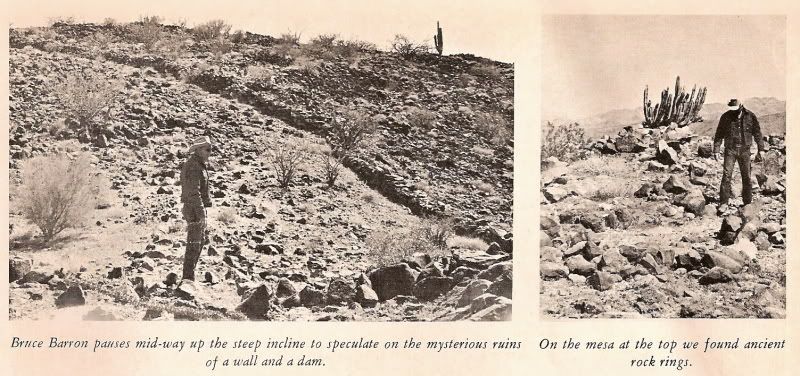
Following a number of Indian insurrections and the destruction of mission properties in 1742, the King of Spain ordered a presidio erected and
instructed the Council of the Indies to propose a plan for the pacification of the whole Baja California territory. As a result, four recommendations
were made, which King Philip V accepted and embodied in a decree dated 1744. These stated that the missionary work of the Jesuits should be continued;
that colonies of Spaniards should be founded near all convenient ports and protected by military posts; that to make quicker conversions among the
natives, missions should be established in the north of the peninsula and united with those of the south; and that the number of missionaries should
be doubled. In return, a complete report and description of missions and mission stations was to be drawn up and sent back to the King.
It was from this report, dated 1745, that we learned Indians had been converted by Friar Fernando Konsag and the mission of Santa Maria Magdalena
begun to the north of existing ones. The Venegas map it is identified as “Mision de Santa Maria Magdalena, empezada” (empezada means “begun”) at about
latitude 29 degrees and within a few miles of the Gulf. No subsequent reference was ever made of this mission and it was not among those inherited by
the Franciscan Order after the Jesuits had been banished from New Spain by the King, as explained earlier.
Judging from the ruins we examined, it appeared likely the original plans had been aborted and the project never completed. However, the plateau atop
the mountain offered an ideal lookout for a military post and it was located close to two convenient ports—those of Bahia de Los Angeles and Las
Animas—in line with the demands of the King. An existing mission trail followed up the center of Baja before crossing to the Pacific Coast, but at the
time Mission Santa Maria Magdalena was instituted, the padres were interested in the Gulf coast, hoping to establish land contact with the missions of
Sonora. No previous Gulf trail then existed. When the mission was abandoned for one reason or another, so was the Gulfo Camino, which we were now
resurrecting.
Author Arthur North wrote in his Camp and Camino in Lower California about a visit in 1904 to ruins of a Jesuit mission chapel named Santa Maria de la
Magdalena about six miles south of Santa Rosalia. However, Peter Gerhard and Howard E. Gulick in their superb Lower California Guidebook referred to
those same ruins as remnants of the Magdalena chapel built by the Dominicans in 1774. They don’t refer to them as a mission at all, which makes good
sense considering that the Dominicans didn’t even get to Baja until 1773 and their first mission, established in 1774, was much further north on the
Pacific coast. The Jesuits began the Santa Maria de la Magdalena mission on the Gulf as indicated on their 1757 map. Because further reference to the
mission is ignored in other records of importance, I am inclined to believe the ruins south of Santa Rosalia were never a mission, but instead are
those of an early Dominican chapel established to serve rancheros and mines in the productive Magdalena and Santa Rosalia mining area.
In some stretches of this virgin area we noted occasional rows of desert-varnished rocks typical of those outlining known mission roads used by pack
trains to transport supplies and messages from one mission to another. Otherwise, nothing indicated the land had been traversed by more than a coyote.
One bad spot, where we came close to giving up, sliced so sharply down into a deep wash that the men worked for over three hours alternately shoveling
and rebuilding the bank into a grade. To negotiate this kind of country, trucks should be hinged in the middle so they bend.
The Automobile Club of Southern California has long since made it through and its map now indicates a dirt road that extends south from Bahia de Los
Angeles.
===========================================================
See the higher resolution 1757 Jesuit map recently posted... here:
http://forums.bajanomad.com/viewthread.php?tid=35292


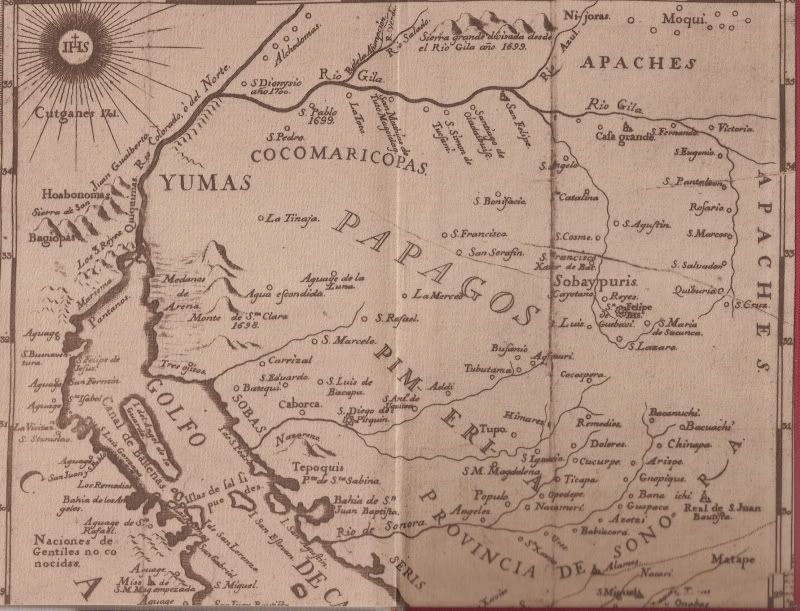
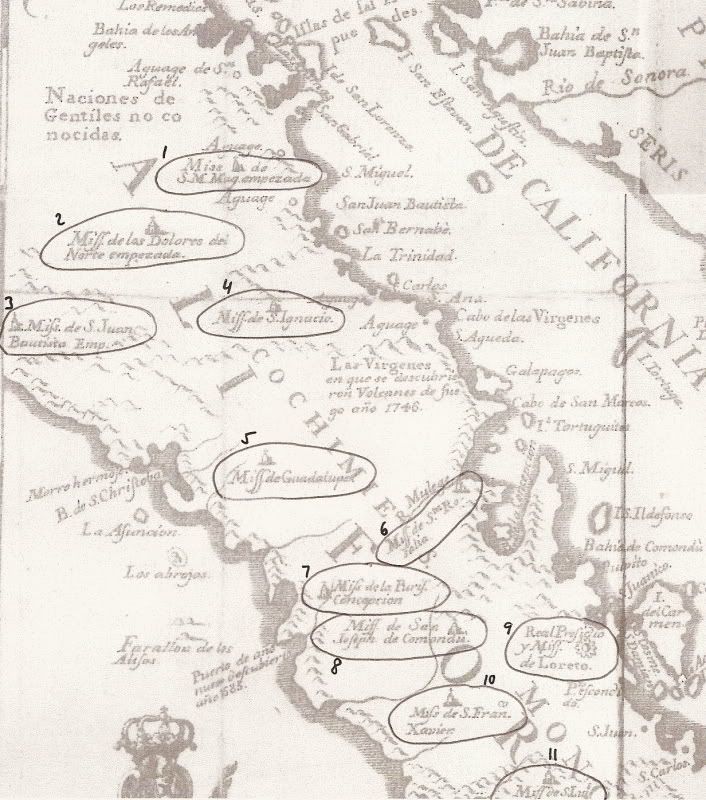
1: S.M.Magdalena 'started'
2: Dolores del Norte 'started'
3: S. Juan Bautista 'started'
4: S. Ignacio
5: Guadalupe
6: Santa Rosalia (de Mulege)
7: La Purisima Concepcion
8: San Jose de Comondu
9: Royal Precidio and Mission of Loreto
10: San Francisco Javier (Xavier)
11: San Luis Gonzaga...
[Edited on 12-17-2008 by David K]
|
|
|
wilderone
Ultra Nomad
    
Posts: 3851
Registered: 2-9-2004
Member Is Offline
|
|
David, you must go to the CAREM office in Tecate and see their library. There, you will find publications by Dr. Michael Mathes, who is the current
authority on Baja CA missions and history. Per Dr. Mathes, there are no "lost missions" and he feels that Choral Pepper's intriguing tales are not
grounded in solid academia.
I only comment because you're so interested in this subject, and I think more factual information will aid your quest for analyzing mysterious
archaeological remains.
Dr. Mathes is living in Texas and the CAREM people may be able to put you in touch with him. You would really enjoy meeting him.
|
|
|
David K
Honored Nomad
        
Posts: 65072
Registered: 8-30-2002
Location: San Diego County
Member Is Offline
Mood: Have Baja Fever
|
|
Thanks Cindi... I am aware of how Dr. Mathes feels about Choral's writings... Choral and I talked quite a bit about him, before she passed away.
Also, I do want to thank you for offering guidence and additional information... it is appreciated and important!
Now, here's some reasonings for the style of Choral's writings and how we mean the term 'lost mission' to be interpreted...
Choral Pepper loved the desert and loved Baja with a great passion... She considered Baja to be a 'magic' place. Choral believed the desert was a
wonderland that was there to be explored for fun, adventure, excitement and education. Erle Stanley Gardner felt the same... and he came to Choral to
invite the Pepper's to join his expeditions in Baja. Because I also share this belief, Choral gave me all her Derert Magazine papers and photos of the
Baja California expeditions she was on... along with the m/s of her unpublished 'last' book... to share with all of you who love Baja the same way.
TRUE: there are NO lost missions in Baja, as each mission was established using donated funds from wealthy Europeans. Each 'true' mission project was
documented...
ALSO TRUE:
1) There is a lot of missing documentation or lacking documentation of mission activities. Many documents of mission activities such as visita
projects may have not been found.
2) There are legends handed down through generations that started from myth or from reality.
3) There is a map that shows TWO missions 'started' that have no other documents to show a fund was used for them (San Juan Bautista in the Santa
Clara mountains, and Santa Maria Magdalena, described above).
4) A third 'started' mission (Dolores del Norte) has frequently been considered to be another mission and not Santa Gertrudis, because of this map.
The extensive visita ruins at San Pablo are often labled as this 'lost' Dolores mission. The elders at San Francisco de la Sierra told Pepper that
their old walls were the remains of 'Dolores' (perhaps an early choice for Dolores before the Santa Gertrudis location was established).
So, with all these possibilities of missing information and nobody now who was alive 250 years ago, there very well could be mission period 'sites'
yet discovered. Using terms such as 'lost mission' has a lot more appeal to an adventure seeker to explore the desert... and I know Choral meant that
only in the best way to create a sense of adventure for us desert rats and Baja lovers.
We do NOT believe in any lost mission treasures (however, one needs to read Herman Hill's new book: 'Baja's Hidden Gold' before getting too sold on
our statement).
We DO believe that the treasure is discovering a lost or forgotten site to add to history's long list of ancient discoveries... So, when myself or any
of you do find an old site, don't let it be lost to the ages... Add it to the history books to expand our knowledge of the past... California's great
history is fantastic!
Please see http://ChoralPepper.com
[Edited on 11-25-2008 by David K]

|
|
|
wilderone
Ultra Nomad
    
Posts: 3851
Registered: 2-9-2004
Member Is Offline
|
|
"We DO believe that the treasure is discovering a lost or forgotten site to add to history's long list of ancient discoveries"
Si, absolutely!
Happy trails..........
|
|
|
David K
Honored Nomad
        
Posts: 65072
Registered: 8-30-2002
Location: San Diego County
Member Is Offline
Mood: Have Baja Fever
|
|
Happy Thanksgiving to you, too!!!
Viva Baja!!
|
|
|
Barry A.
Select Nomad
      
Posts: 10007
Registered: 11-30-2003
Location: Redding, Northern CA
Member Is Offline
Mood: optimistic
|
|
Great and fascinating information, David.
HAPPY THANKGIVING to you and Baja Angel.
Barry
|
|
|
David K
Honored Nomad
        
Posts: 65072
Registered: 8-30-2002
Location: San Diego County
Member Is Offline
Mood: Have Baja Fever
|
|
Thank you Barry!
I look forward to more Baja exploring soon and sharing with you and the rest of the gang here on Baja Nomad!
Happy Thanksgiving!
|
|
|
David K
Honored Nomad
        
Posts: 65072
Registered: 8-30-2002
Location: San Diego County
Member Is Offline
Mood: Have Baja Fever
|
|
Photos from the 1966 expedition
Some photos are already at ChoralPepper.com from the February, 1966 trip (Erle in his new Bronco, etc.)... Yesterday, I went through more of the files
that Choral left to me and scanned the following from that trip:
The Grasshopper (JW Black's dune buggy creation) took them exploring and is how they found the ruins.

How they knew where they were...
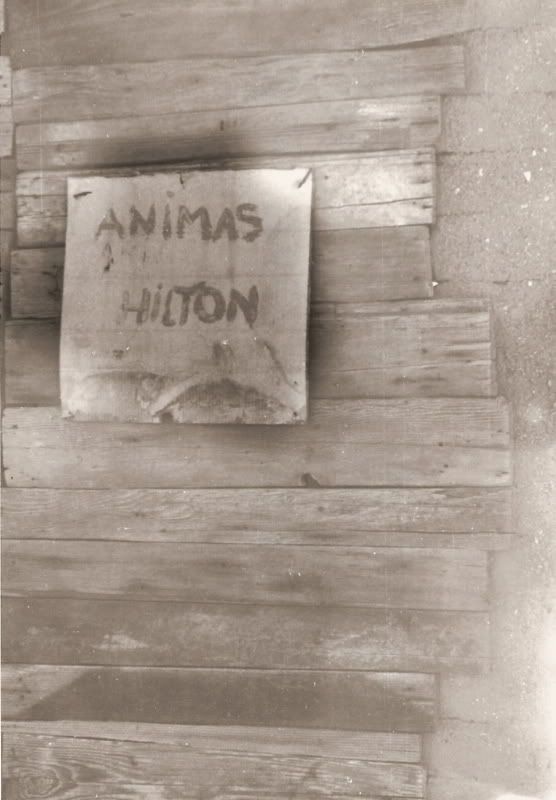
Digging for clams at Bahia las Animas.
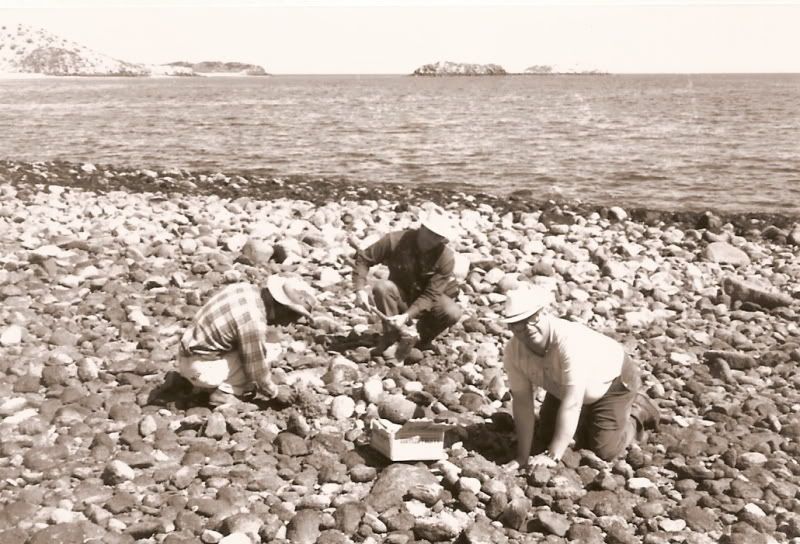
The Gardner camp, somewhere along the Gulfo Camino.
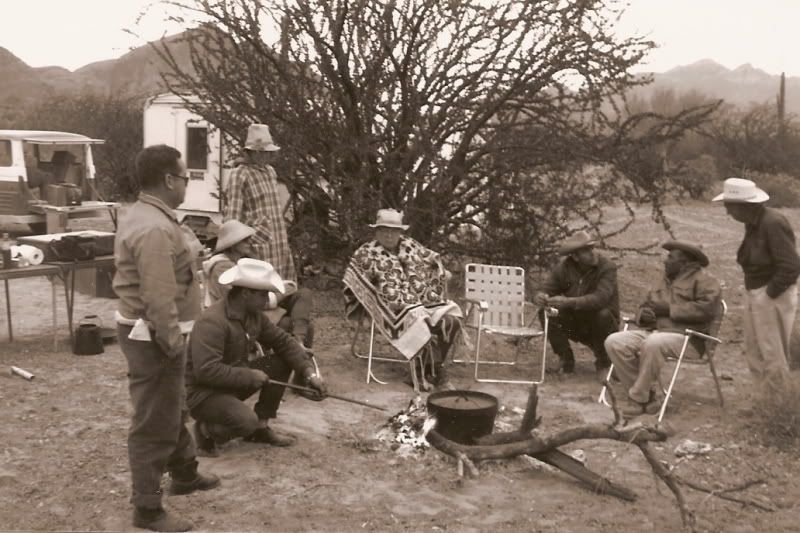
|
|
|
BajaGringo
Ultra Nomad
    
Posts: 3922
Registered: 8-24-2006
Location: La Chorera
Member Is Offline
Mood: Let's have a BBQ!
|
|
Great photos and story David...
|
|
|
BajaGringo
Ultra Nomad
    
Posts: 3922
Registered: 8-24-2006
Location: La Chorera
Member Is Offline
Mood: Let's have a BBQ!
|
|
Obviously you have spent a lot of time on this David and my question may appear novice, so forgive me if it be so...
Can you gleam any insight as to the location of the ruins from the form of the mountain ridge behind in the second photo depicting the ancient rock
rings?
|
|
|
David K
Honored Nomad
        
Posts: 65072
Registered: 8-30-2002
Location: San Diego County
Member Is Offline
Mood: Have Baja Fever
|
|
I have made 5 trips into the area specifically to find the site and that mountain range in the background... those trips are listed on this page: http://vivabaja.com/1757/page2.html
With help from other Nomads who are keeping their eyes open, I do believe the site will be re-discovered soon! In fact, I am sure of it!!
Before Choral passed away, 6 years ago, she told me she really hoped I would find it. She had tried a few years earlier, but the road wasn't passable.
It must have not been that big of a deal to the rest of the group at the time... just an old wall and dam... because nobody remembered the exact
location and Gardner himself didn't mention it in his book that detailed the trip (Off the Beaten Track in Baja, 1967).
|
|
|
Sharksbaja
Elite Nomad
     
Posts: 5814
Registered: 9-7-2004
Location: Newport, Mulege B.C.S.
Member Is Offline
|
|
 Now that's confidance. Now that's confidance.
I've already found it and planted an American Flag at the summit! You will see it when you get there.
[Edited on 1-7-2009 by Sharksbaja]
DON\'T SQUINT! Give yer eyes a break!
Try holding down [control] key and toggle the [+ and -] keys
Viva Mulege!
Nomads\' Sunsets
|
|
|
David K
Honored Nomad
        
Posts: 65072
Registered: 8-30-2002
Location: San Diego County
Member Is Offline
Mood: Have Baja Fever
|
|
What did the flag of Spain look like in the 1750's? That is the one that should be planted! 
State and War Ensign 1701-1759 (Spain)
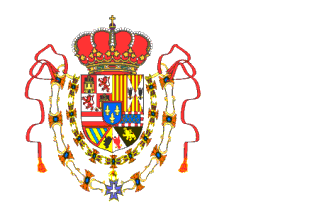
[Edited on 12-2-2008 by David K]
|
|
|
Vince
Nomad
 
Posts: 447
Registered: 10-17-2006
Location: Coronado
Member Is Offline
|
|
Fascinating stories and photos, David! You have been the perfect steward of Choral Peppers donated material, we look forward to more. Reading all
that reminds me of the stories of Bud Bernhard. One story he told me was of the hidden gold and treasure just inside Bahia Conception near the sandy
beach on the peninsula side. He explored the area several times looking for it but obviously no luck. I stop there often to explore and clean fish,
but never had a pick and shovel with me. Then there was the one about the 30 foot rattlesnake in the Sierra Martir Mountains......
|
|
|
Von
Senior Nomad
  
Posts: 961
Registered: 10-1-2006
Location: Poway-Rosarito
Member Is Offline
Mood: getting ready!
|
|
David , next time you head south i want to come with you my friend ok .
Wish I could leave this very minute take all the time in the world looking for a treasure that would be so cool........
READY SET.....................
|
|
|
David K
Honored Nomad
        
Posts: 65072
Registered: 8-30-2002
Location: San Diego County
Member Is Offline
Mood: Have Baja Fever
|
|
| Quote: | Originally posted by Vince
Fascinating stories and photos, David! You have been the perfect steward of Choral Peppers donated material, we look forward to more. Reading all
that reminds me of the stories of Bud Bernhard. One story he told me was of the hidden gold and treasure just inside Bahia Conception near the sandy
beach on the peninsula side. He explored the area several times looking for it but obviously no luck. I stop there often to explore and clean fish,
but never had a pick and shovel with me. Then there was the one about the 30 foot rattlesnake in the Sierra Martir Mountains......
|
Thank you Vince... very nice of you to say! Choral did believe I would and I have been ... There is still more to come! It would be great to have her
last Baja book published... and in time, it will... Until then I will keep sharing parts of it here on Nomad, as Choral would have wanted.
|
|
|
David K
Honored Nomad
        
Posts: 65072
Registered: 8-30-2002
Location: San Diego County
Member Is Offline
Mood: Have Baja Fever
|
|
| Quote: | Originally posted by Von
David , next time you head south i want to come with you my friend ok .
Wish I could leave this very minute take all the time in the world looking for a treasure that would be so cool........ |
Thank for the excitement you show Von... Choral knew her style of history writing was what inspired people to get out into the desert and make
discoveries!
The treasure is seeing something that has survived in the harsh Baja enviroment for over 200 years... even if it just a stone wall or a section of the
Canino Real!
See http://ChoralPepper.com
|
|
|
Fatboy
Senior Nomad
  
Posts: 798
Registered: 6-28-2005
Member Is Offline
|
|
| Quote: |
Gardner himself didn't mention it in his book that detailed the trip (Off the Beaten Track in Baja, 1967).
|
For some reason that sounds wrong, I known I read about it in Choral's little book about the missions, but something nags me that i had read about it
before then...who knows could just been an earlier reading of the same thing...
Next time we go down to Las Animas we need to explore more than the 'beach'...
[Edited on 12-3-2008 by Fatboy]
|
|
|
David K
Honored Nomad
        
Posts: 65072
Registered: 8-30-2002
Location: San Diego County
Member Is Offline
Mood: Have Baja Fever
|
|
| Quote: | Originally posted by Fatboy
| Quote: |
Gardner himself didn't mention it in his book that detailed the trip (Off the Beaten Track in Baja, 1967).
|
For some reason that sounds wrong, I known I read about it in Choral's little book about the missions, but something nags me that i had read about it
before then...who knows could just been an earlier reading of the same thing...
Next time we go down to Las Animas we need to explore more than the 'beach'...
[Edited on 12-3-2008 by Fatboy] |
It was indeed Choral's 'little book' that inspired me to learn more about the missions, particularly the 'lost' or forgotten ones... I inspired Dr.
Jackson to dig up the details on Dolores del Norte because he hates the term 'lost mission' insisting there are none. Dr. Jackson ('academicanarchist'
on Nomad) traveled to my home from Texas and worked with me on the edit of Choral's manuscript and added a lot more mission details... enough to make
a seperate book.
If the walls, dam and rock circles they saw in 1966 are indeed a mission project that was abandoned, then Choral believes it was the 'Santa Maria
Magdalena' shown on the 1757 map.
Jackson, Weber, and other Jesuit historians confirm that Dolores del Norte was an early name for the mission that became Santa Gertrudis... it was
never a seperate mission south of Santa Gertrudis as some books, maps and INAH have shown. The people of San Francisco de la Sierra may have thought
the mission-era walls in their village were Dolores (as they told the Gardner party in the early 60's) because it may have been an early proposed site
and so that name was passed down through the generations.
The third 'lost mission' is one that still has no physical evidence... and that is the lost Santa Clara mission near Punta Abreojos... shown on the
1757 map as "Mission San Juan Bautista, started". The ejido people at Abreojos know of 'Santa Clara' and a South African man has made repeated trips
into the strange looking mountains, so I have been told... Who knows for sure???
If you find it Fatboy, please take lots of photos and share them with us... I traveled to Las Animas in 2004, and tried to spot a mountain range like
the photo shows... as I did on the other trips into the La Bocana Valley.
Thank you!
|
|
|
David K
Honored Nomad
        
Posts: 65072
Registered: 8-30-2002
Location: San Diego County
Member Is Offline
Mood: Have Baja Fever
|
|
The search goes on!
Here is a map of the old road (the route Gardner and friends took in 1966) south of L.A. Bay, in Valle la Bocana...
The arrows with numbers are the places we made searches, on foot, for that wall seen in the Pepper photograph. Also, while driving the road we tried
to see mountain ranges that looked like the one in the background of the second Pepper photograph.
Choral Pepper believed the old wall and other rock piles at the site were the start of a proposed mission to be called Santa Maria Magdalena... as
shown in this area on the 1757 Jesuit map. A bell with the new mission's name was cast and ended up hanging at Santa Gertrudis (the closest mission to
this site). If this was a mission-era site, it was never recorded beyond the 1757 map.
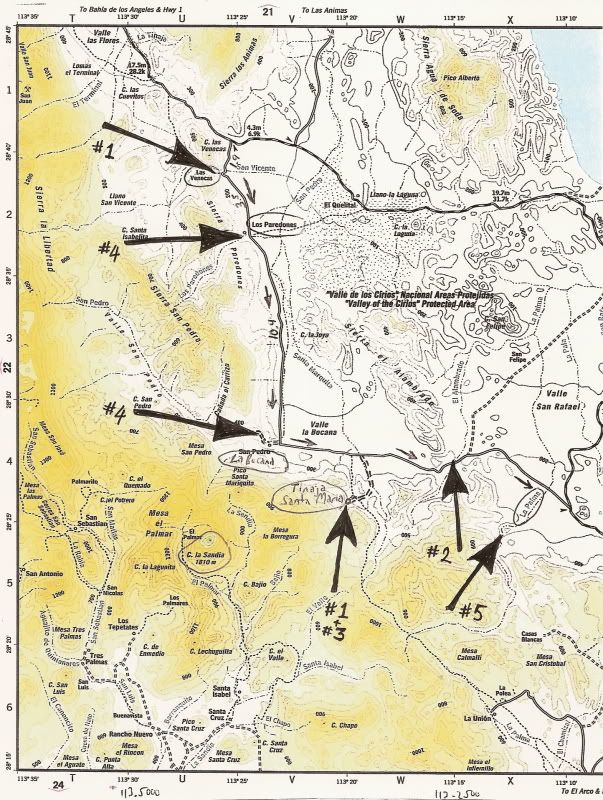
'Lost Mission' Search dates (links to photos taken on these trips at http://vivabaja.com/1757/page2.html :
#1: July, 2001
#2: April, 2002
#3: Jan., 2003
#4: April, 2003
#5: Jan., 2004
David K's search for Santa Maria Magdalena (Photos):
#1) July, 2001
#2) Apr, 2002
#3) Jan, 2003
#4) Apr, 2003
#5) Jan, 2004
[Edited on 12-21-2008 by David K]
|
|
|
| Pages:
1
2 |
|

